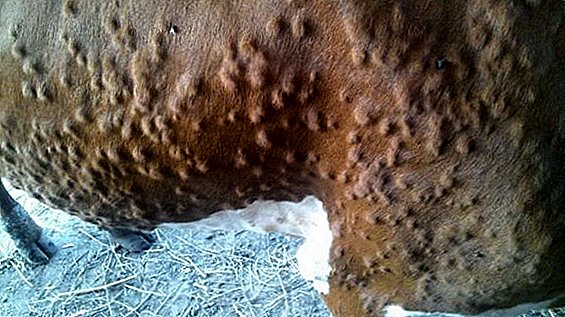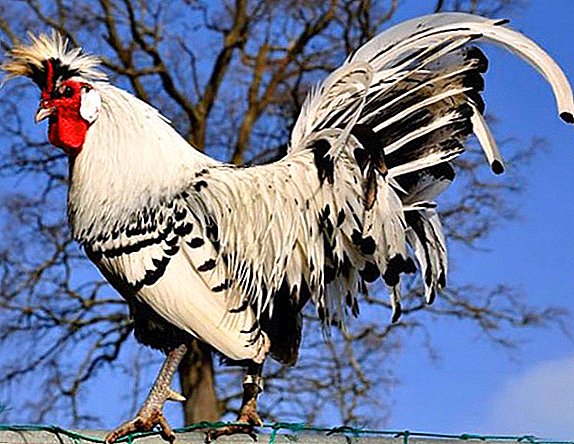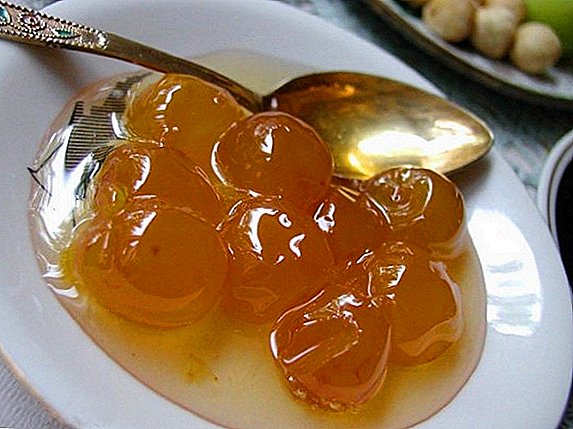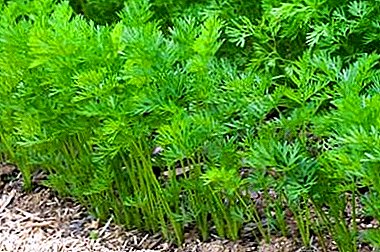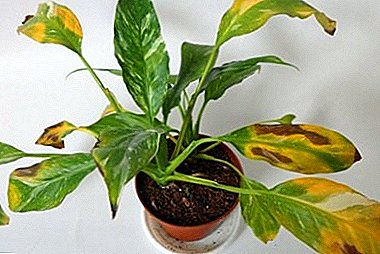
Increasingly, exotic plants with difficult to pronounce names can be observed in pots of room-pot lovers. One of these plants - "female happiness" or Spathiphyllum.
Spathiphyllum - a beautiful indoor plant, comes from the forests of South America and Brazil. It is believed that this truly female plant can bring its owner the warmth of the family hearth and the joy of motherhood. In return, Spathiphyllum will require competent care and attentive attitude.
On which parts of the plant may appear brown or other spotting?
The first signs of plant disease appear on the leaves as spots, yellowing and drying of the leaf edge. The color of the spots and their localization may be different.. Depending on these conditions, it is necessary to identify the causes and eliminate them in time.
Why is this happening?

- The appearance of spots on the leaves of Spathiphyllum is a consequence of improper care or damage by pests. It can be said that the plant responds to a stressful situation in this way.
- Excessively dry indoor air may cause the leaves to dry. At first, the edge is affected, then blackening extends to the entire area of the sheet.
- If the plant is located in a place where it is constantly exposed to direct sunlight, you can get burned leaves. This will manifest itself in the appearance of brown spots on the leaves.
- Excessive shading leads to a slow death of the plant. The first sign is sheet rolling, loss of a natural shape.
- It is important to comply with the technology of watering. Spathiphyllum loves moderate watering without stagnant water in the root area.Dryness of the upper layers of the soil is quite acceptable. Land should have good drainage and be loose.
Such conditions will allow excess water to drain into the pan and will protect against the occurrence of root rot. When choosing water it is worthwhile to stay at boiled or separated, preferably room temperature.
- Fertilizers need to be 2 times a month in the summer and spring periods. In autumn and winter - two times less. It is important not to overdo it so that there is no chemical burn, or poisoning. Symptoms - a sharp darkening of the leaves. If there is a lack of fertilizer, the leaves take on a yellow color.
- Spathiphyllum can be affected by pests (scutes, spider mites) and diseases (phytophthora, powdery mildew, gray mold). Sick plants should be isolated from healthy specimens.
- Root overcooling occurs when the temperature drops sharply after irrigation, for example, during night frosts, the plant is on the windowsill. This is manifested in a sharp blackening of the leaf, the center can be the focus.
What threatens the plant?
 The appearance of spots on the leaves of spathiphyllum indicates that something has gone wrong. This may be a reaction to stress, or a disease of the plant. If the time does not understand and fix the problem, the flower stops developing, stops blooming, or dies.
The appearance of spots on the leaves of spathiphyllum indicates that something has gone wrong. This may be a reaction to stress, or a disease of the plant. If the time does not understand and fix the problem, the flower stops developing, stops blooming, or dies.
For example:
- Black mushroom in the advanced stage, the plant essentially “stops breathing”, the process of photosynthesis is disturbed, and the spathiphyllum fades.
- Spider mite able to quite a short time to ruin the plant.
- Wrong lighting fraught with not only sunburn of the leaves, but also stop the growth of the plant. It is necessary to observe the balance of light and shadow.
- Blackening of the leaves due to freezing of the roots lead to the death of part of the green leaves. In this case, the plant will have to reanimate, until the transplant. In any case, when spots appear on the leaves, one must act to prevent the plant from perishing.
What to do if dark or other spotting appears: step by step instructions
After identifying the causes of stains on the leaves, you need to resort to control measures.
- Check the soil. It should not be overmoistened, ideally one third of the top should be dry. The soil should not be too dense. If lumps form on the roots, they will interfere with the normal absorption of water. This happens when excessive watering and improper transplant plants. These lumps should be carefully removed from the root in a bucket of warm water.
If the process breaks the spine, the place of breaking should be treated with activated charcoal. You can add a little to the soil. A good solution would be soil treatment with a foundation solution (2 grams of a substance per liter of water).
- Healthy roots will be solid and white.
- If there are areas with signs of rotting (soft and brown), they should be removed with a clean, sharp knife.
- Cut the cut sites with activated charcoal or ground cinnamon.
- After transplanting the plant into the prepared soil with a drainage of vermiculite or perlite.
- Apply to the treatment of the plant, the Topsin-M, Skor-containing solution of Fungicide-containing solution.
- After transplantation, do not immediately water.
- The location of the flower plays an important role in its life. It is necessary to monitor the temperature and humidity, to keep balance. The plant does not like sudden changes in temperature, it is impossible for the leaves to touch the cold windows in winter, but hot air from radiators is not the best solution.
- If there is yellowing of the leaves for one of the reasons, then you need to stop watering, let the soil dry for a third of the top. Remove flower from direct sunlight, ideal to use a humidifier. You can put next to the plant container with water.
- If the inspection of the soil, the root system and the normalization of irrigation does not give results, it is possible that there is a lack of minerals in the soil. Spathiphyllum for proper development and flowering requires timely moderate feeding. From folk remedies fit chicken droppings. It is also not superfluous to add nitrogen-containing fertilizers.
Disease prevention
 Preventive measures to prevent spathiphyllum disease:
Preventive measures to prevent spathiphyllum disease:
- Indoor humidity control. The plant does not like too dry air.
- Normalization of irrigation. An excess of moisture will lead to rotting of the roots, and the possible death of the plant. Lack of fluid to wilt a flower. It is possible to use a non-standard method when the pot is placed in a two-thirds height in a container with water. After the excess water should drain into the tray from which it will be immediately removed.
- Remove the plant from an uncomfortable place to stay, away from cold glasses or hot batteries. The moderate shadow is not terrible for Spathiphyllum.
- Use boiled or distilled water when watering. Room temperature.
- Preventive examinations of the plant.
It is important not to miss the moment of occurrence of repeated signs of the disease. The earlier the syndromes are noticed, the easier the treatment process.
- Isolation from healthy plants. After resuscitation, the plant needs increased attention, a relapse is likely.
- Preventive treatment of plants drugs from pests and diseases. Spider mite, Shchitovka, Mealybug.
- Provide fresh air. Daily ventilation without hypothermia has a beneficial effect on the plant.
- Time to remove the reappearance of the disease. Cut off dead, withered tips of the leaves.
The best treatment is prevention. In order for your flower to be always healthy and to please the eye with blossoming flowers, you need to ensure it is properly cared for. Spathiphyllum is not capricious, but requires minimal attention, like any exotic plant.



